To resolve the QuickBooks Event ID 4 error, you can use the QuickBooks Tool Hub to run the “Quick Fix My Program” and “QuickBooks Install Diagnostic Tool,” or manually reinstall QuickBooks using the Clean Install Tool. You can also try to reinstall or repair the Microsoft .NET Framework.
QuickBooks Event ID 4 Error occurs when the Microsoft .NET Framework or the QuickBooks company file structure malfunctions, disrupting QuickBooks operations and producing unexpected error logs in the Windows Event Viewer.
When triggered, the error prevents QuickBooks from connecting to its Database Server Manager and may display messages such as “Integration Manager could not connect to QuickBooks” or “Returning NULL QBW in Instance Handle.”
This article provides a comprehensive resolution framework: identifying core causes, assessing system performance impact, and applying verified solutions to restore functionality. It outlines structured troubleshooting procedures—using diagnostic utilities, repairing or reinstalling .NET Framework components, cleaning QuickBooks installations, and correcting registry or network configurations.
Additionally, it covers preventive maintenance, advanced environment checks, and proactive system adjustments to ensure long-term QuickBooks stability and prevent recurrence of Event ID 4 errors.
What is error 4 in the QuickBooks Desktop Event ID log & how does it look when it occurs?
The QuickBooks Event ID 4 error typically occurs due to a corrupted .NET Framework when users try to initiate the QB Integration Manager, damaged system files(QBW), a corrupt installation, conflicts with third-party software, or due to a Windows registry error.
Users’ data gets hampered as users might lose their company file data or some other important data.
Note: This error is primarily triggered when the .NET Framework 4.0 on Windows 7 ceases to function as expected.
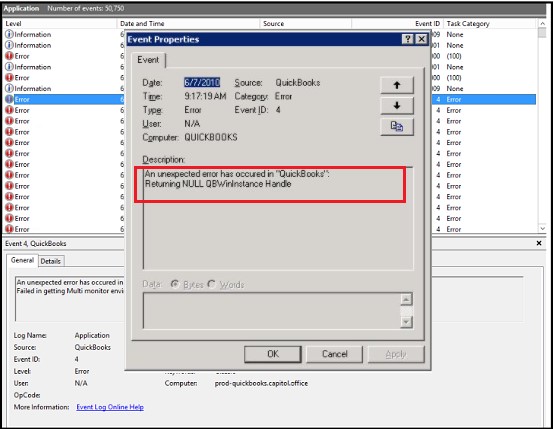
Being a Windows-specific error, it has the potential to impact QuickBooks even when it’s installed on a server.
Upon the occurrence of this error, you will get the following error messages on your computer screen:
| “Integration Manager could not connect to QuickBooks. Please make sure that it is open” when it takes place.” |
| “QuickBooks event ID 4 – An unexpected error has occurred in QuickBooks: Returning NULL QBW in Instance Handle”. |

What are the Root Causes Behind the QuickBooks Event ID Log Error 4?
The QuickBooks Event ID 4 error is triggered by issues related to the .NET framework. A specific problem in .NET Framework 4.0 SP 1 is the primary cause behind the occurrence of this error. Other interconnected issues include corrupt or damaged company files that disrupt core operations, problems with the Microsoft .NET Framework that impair essential QuickBooks functions, incomplete or faulty QuickBooks installations, and Windows Registry errors that destabilize system settings. Additionally, conflicts with third-party applications, virus or malware infections, accidental deletion of critical QuickBooks files, insufficient user permissions, Database Server Manager problems, firewall or antivirus software blocking processes, and outdated QuickBooks or Windows versions create compatibility and access issues. These causes collectively impact QuickBooks’ ability to run smoothly, leading to crashes or failure to open company files. Addressing these areas by repairing files, updating software, fixing registry errors, adjusting permissions, and resolving security conflicts typically restores normal function quickly. To help you fix the issue, here are the key causes you should check first:
Here are other possible factors that may be the root cause of this error:
- Damage or Corruption of QuickBooks Company File (QBW): The company file is a crucial component of QuickBooks. If this file gets damaged or corrupted due to any reason, it can lead to this error.
- Conflicts with third-party software: Other software can interfere with QuickBooks operations, leading to this error.
- Virus or Malware Attack: If QuickBooks files are affected by a virus/malware, it can result in QB Event error ID 4.
- Incomplete or Corrupt Installation of QuickBooks Software: If the installation of QuickBooks software is not completed properly or if the installed files are corrupt, it can cause this error.
- Windows Registry Error: Errors in the Windows registry can also lead to QuickBooks error ID 4. In the Windows registry database, Windows and its applications store their settings. If there’s an error in this database, it can affect the functioning of QuickBooks and the entire system.
- Accidental Removal of Essential QuickBooks Related File: Sometimes, a background running application might accidentally delete an essential file related to QuickBooks, leading to this situation.
Understanding these potential causes can help in troubleshooting and resolving QuickBooks Event ID 4 effectively.
How does QuickBooks Event ID Log Error 4 affect system Performance and Data Integrity?
QuickBooks Event ID 4 is an error associated with the QuickBooks Database Server Manager, indicating issues with the QuickBooks company file or its connection. This error can adversely affect system performance and compromise data integrity.
Impact on System Performance:
- Resource Consumption: The error may cause the QuickBooks Database Server Manager to consume excessive system resources, leading to slow performance or unresponsiveness.
- Network Latency: In multi-user setups, Event ID 4 can result in network delays, affecting the efficiency of collaborative tasks.
Impact on Data Integrity:
- Data Corruption: Frequent occurrences of this error can lead to corruption of the QuickBooks company file, risking data loss or inaccuracies.
- Transaction Errors: Users might experience incomplete or erroneous transactions, affecting financial records and reporting.
How Can We Identify the Effect of QuickBooks Event ID Log Error 4?
When the QuickBooks Event ID 4 users will face the following symptoms:
- QuickBooks might become unresponsive, slow, or even stop working.
- An error alert could be displayed on your monitor.
- The system might become noticeably sluggish, failing to respond to mouse clicks and keyboard inputs accurately.
- You could face issues with Windows OS, such as crashes, freezes, and slow performance.
- The error could surface on your screen, leading to the crash of any open Windows application.
The following error messages may be displayed to the user on their screen in the case of QuickBooks Event ID 4:

| An unexpected error has occurred in “Intuit QuickBooks Enterprise Solutions: Manufacturing and Wholesale 19.0”: DB error -210 ErrorMessage:’User ‘456964656e’ has the row in ‘LOCKS’ locked’ from file:’src\sadbsess.cpp’ at line 4727 from function:’SADBSession::AcquireLock |
| An unexpected error has occurred in “QuickBooks: Point of Sale 2020”: WPR: OpenPrinter call failed. |
| An unexpected error has occurred in “QuickBooks: Desktop Pro 2020”: WPR: calling ABORT_CLOSE. |
| An unexpected error has occured in QuickBooks: MainFrame must be already created by now as this dll is demand loaded |
| An unexpected error has occurred in “Intuit QuickBooks Enterprise Solutions: Manufacturing and Wholesale 19.0”: DMError Information:-6123 Additional Info: The server we are attempting to attach to can’t be found. |
| WPR: calling ABORT_CLOSE in the event log – not on the server, but on the client machine. |
| An unexpected error has occurred in “QuickBooks: Premier Edition 2020”: WPR: SetNameDriverAndPort call failed. |
| An unexpected error has occurred in “QuickBooks: Premier Accountant Edition 2020”: WPR: validation failed. |
Solutions to Fix QuickBooks Event ID Log Error 4
Solution 1: Use the QuickBooks Install Diagnostics Tool or Repair The QuickBooks Application
Step 1: Download the QuickBooks Install Diagnostic Tool
- It is important to first download the QuickBooks Tool Hub, which is built to identify and fix issues with QuickBooks automatically.
Step 2: Install the QuickBooks Install Diagnostic Tool
- Once the download is complete, proceed to install it. The installation wizard will guide you through the steps necessary to install the tool on your system.
Step 3: Close the Applications
- After the installation is complete, it’s important to close any applications running in the background. These could interfere with the diagnostic tool’s ability to troubleshoot issues effectively.
Step 4: Run the Diagnostics Tool
- With the background applications closed, you can now run the QuickBooks Install Diagnostic Tool. The QBIDT tool will scan your system for any issues related to QuickBooks and attempt to fix them automatically.
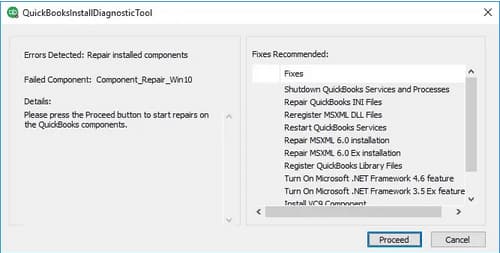
Step 5: Restart the System
- Finally, after running the diagnostic tool, restart your computer. This ensures that any changes made by the tool are properly implemented. After the restart, check to see if your issue with QuickBooks has been resolved.
Solution 2: Close the QuickBooks Running Background Program & Log in to Your System As An Administrator
Before moving on to applying any solutions, consider the following:
- Back up your essential data, as it protects your information in case anything unexpected happens during the troubleshooting process.
- Close any applications running in the background.
- Ensure you have a stable internet connection.
- Also, make sure your antivirus system is temporarily disabled.
The following are the steps to close QuickBooks running background programs and log in to your system as an administrator:
Step 1: Close QuickBooks Running Background Programs
- Press Ctrl + Shift + Esc to launch the Task Manager.
- Close all ongoing programs.
- Additionally, click on the Processes tab.
- Look for any processes that are related to QuickBooks, such as QBW32.EXE, qbupdate.exe, and QBDBMgrN.exe.
- Click on each of these processes and then click on the End Process button to close them.
Note: Please note that you should only end a process if you know what it does. Ending important system processes can cause problems.
Step 2: Log in to Your System as an Administrator
- Click on the Start button and select the user icon on the top left of the Start menu.
- Select the Administrator account from the list. If you’re asked for a password, enter it.
- Once you’re logged in as an administrator, you can make the necessary changes to QuickBooks or any other programs on your system.
Note: Always be careful when logged in as an administrator, as it gives you full control over your system. Misusing this power can lead to data loss or damage to your system.
Solution 3: Run Quick Fix My Program & QuickBooks File Doctor
The QuickBooks Event ID 4 error usually happens when there’s a problem with the .NET Framework or your QuickBooks company file. Quick Fix My Program is a tool in QuickBooks that can close any background processes and quickly fix your program.
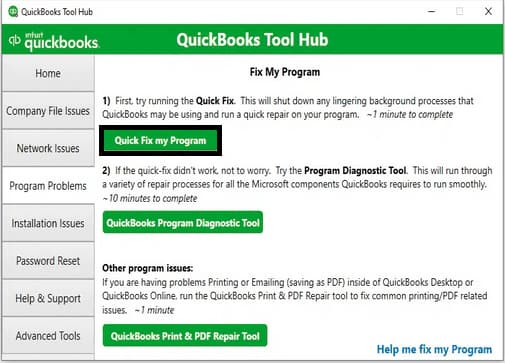
Run the Quick Fix My Program to attempt to fix the QuickBooks Event ID 4 error. If the error is still there after using the quick fix my program, you should then download, install, and use the QuickBooks File Doctor. This tool checks your QuickBooks file for any issues and fixes them. Using these tools can help get rid of the QuickBooks Event ID 4 error.
Solution 4: Manually Fix the .NET Framework on Windows
Step 1: Navigate to the Windows Start menu, type in Control Panel, and press Enter.
Step 2: Launch the Control Panel window from the results that appear.
Step 3: Select the Programs and Features tab.
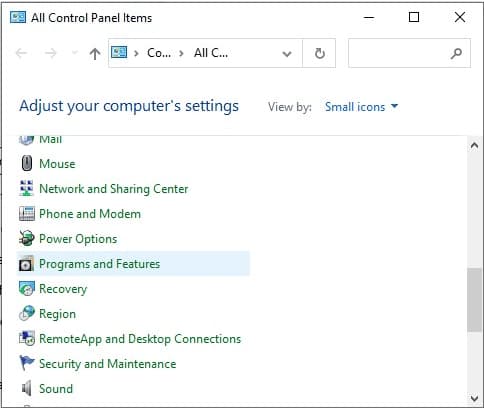
Step 4: From the options that appear, choose Uninstall a Program.
Step 5: Then, click on Turn Windows features on or off.
Note: Administrator permission or privilege is required to turn the Windows features on/off.
Step 6: Look for .NET Framework in the list of programs displayed.
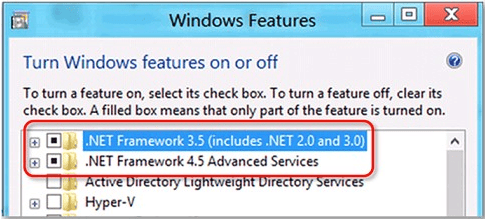
Step 7: Verify the settings for both .NET Framework 4.5 (including 4.6, 4.7 & 4.8 versions) and .NET Framework 3.5 SP1.
If the .NET Framework 4.5 (or later) checkbox is not checked, do the following steps:
Step 1: Enable the ‘.NET Framework 4.5 (or later)’ checkbox.
Step 2: Click OK to save the changes.
Step 3: Reboot your computer.
If the .NET Framework 4.5 (or later) checkbox is checked, do the following:
Step 1: Disable the ‘.NET Framework 4.5 (or later)’ checkbox.
Step 2: Click OK to save the changes.
Step 3: Restart your system.
Step 4: After logging back into Windows, repeat the steps to enable your .NET Framework 4.5.
If the .NET Framework 3.5 SP1 checkbox is not checked, do the following:
Step 1: Enable the ‘.NET Framework 3.5 SP1’ checkbox.
Step 2: Click OK to save the changes.
Step 3: Reboot your computer.
If the .NET Framework 3.5 SP1 checkbox is checked, do the following:
Step 1: Disable the ‘.NET Framework 3.5 SP1’ checkbox.
Step 2: Click OK to save the changes.
Step 3: Restart your computer.
Step 4: After logging back into Windows, repeat the steps to enable your .NET Framework 3.5 SP1.
Note: If turning the .NET Framework on/off does not resolve the QB error, consider repairing the installed .NET Framework program. If the QB Event ID 4 error continues, you may need to uninstall and reinstall the framework.
Solution 5: Reinstall the .NET Framework on Windows
Step 1: Press the Windows + R keys simultaneously to open the Run window on your system.
Step 2: Type the term “appwiz.cpl” in the Run dialog box and press the Enter key on your keyboard.
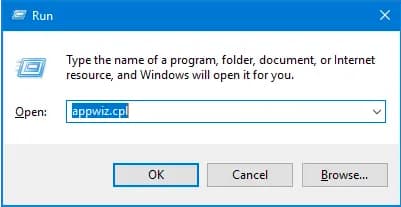
Step 3: You will see an option to Add/Remove all programs under the programs and featured list.
Step 4: Find and select Microsoft .NET Framework 3.5 (or later versions).
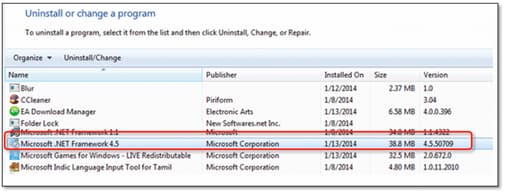
Step 5: Choose the Uninstall option.
Note: The uninstallation process will take about 1-2 minutes
Step 6: After the uninstallation process is complete, restart your system.
Step 7: Once your system restarts, repeat step 1 to open the Run window again.
Step 8: Type Control Panel and launch the control panel.
Step 9: You will now see the Add/Remove programs or Programs & Features window.
Step 10: There is an option to Add or Remove Windows Features located on the left side of the window.
Step 11: Click on the Add or Remove Windows Features option.
Step 12: From the list of programs, click on Microsoft .NET Framework to expand it.
Step 13: Check the first and second boxes.
Step 14: Press OK. The installation of Microsoft .NET Framework will begin after clicking the OK button.
Step 15: Click on the finish button once the task is complete.
After the successful installation of Microsoft .Net Framework 3.5, restart your system and open QuickBooks Integration Manager again.
Solution 6: Rectify the Registry Editor to Fix Event ID 4 in QuickBooks
Before making any changes to your registry, it’s crucial to back it up.
Back up the Windows registry by following the steps below:
Step 1: Open the Run Dialog Box
- Push Windows + R to open the Run dialog box.
Step 2: Open Registry
- Type “regedit” and press Enter. In the Registry Editor, choose File > Export.
Step 4: Take a File Backup
- Save the backup file to the location of your choice.
Follow the following steps to rectify the Windows registry:
Step 1: Go to Registry
- Navigate to the Registry Editor. In the Registry Editor, use the left sidebar to navigate to the following key:
“HKEY_LOCAL_MACHINE\SOFTWARE\Microsoft\Windows\CurrentVersion\Run\OptionalComponents\IMAIL”
Step 3: Locate and Modify the key
- Under this key, look for the subkey related to QuickBooks Error ID 4. Modify the key by right-clicking on the subkey and selecting Modify.
Step 4: Change the ‘Value Data Box’
- In the Value data box, if the current string value is “1,” change it to “0”. If it’s “0,” change it to “1”.
Step 5: Save the changes
- Click `OK` to save your changes.
Step 6: Restart the system
- Restart your computer after modifying the registry to let the changes take effect. Lunch QuickBooks to see if the error has been resolved.
Solution 7: Use Windows System File Checker
The System File Checker (SFC) allows users to scan for problems in the system and rectify them. This can potentially be useful when dealing with issues related to QuickBooks files and related issues.
Here are the steps on how to use Windows System File Checker:
Step 1: Open CMD
- Open the Command Prompt. To do this, click on the Start button and type ‘Cmd’ into the search bar. The search results will display an application named ‘Cmd.’ Right-click on it.
Step 2: Run Administrator Command Prompt
- Select the Run as administrator option. (This allows the Command Prompt to make changes to your system files.) Upon doing this, the Administrator Command Prompt with a black background will open up.
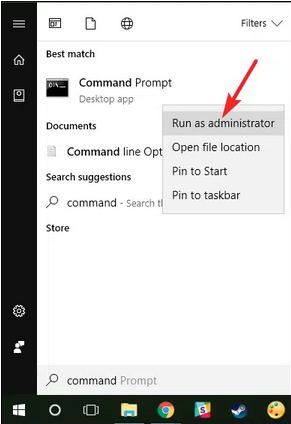
Step 3: Scan the System Files
- Inside this window, you’ll see a command line where you can input commands. Type th term “SFC/Scannow” and press the Enter key. This command initiates the System File Checker, which will then begin scanning your system files for any errors or corruptions.
Solution 8: Reinstall QuickBooks and Use the Clean Install Tool
First Step: Uninstall QuickBooks
To uninstall QuickBooks manually, complete the following steps:
Step 1: Navigate to the Control Panel
- Click the start button. Enter ‘Control Panel’ in the search bar and hit Enter.
Step 2: Access Program & Features
- Open the ‘Programs & Features’ tab.
Step 3: Go to Uninstall Option
- Locate the QuickBooks Desktop and right-click on it. From the drop-down menu, select the ‘Uninstall’ option. Follow the on-screen instructions to complete the uninstallation.
Second: Reinstall QuickBooks using the QuickBooks Clean Install Tool
Download and run the QuickBooks clean install tool after uninstalling the QuickBooks application, and then proceed to clean install QuickBooks.
To perform a clean installation, complete the following process:
Step 1: Launch the QB clean install tool.
- You first need to launch the QB clean tool in order to begin with the process.
Step 2: Perform a QuickBooks Clean Installation.
- The next step is to perform the QuickBooks Clean Installation.
Solution 9: Update QuickBooks Software to The Latest Release
Using an outdated version might result in compatibility problems, which could cause errors such as QuickBooks event ID 4.
Complete the following steps to update your QuickBooks software to the latest version:
Step 1: Open the QuickBooks Application
- Launch the QuickBooks Desktop application.
Step 2: Go to the help menu
- Navigate to the “Help” menu located in the toolbar at the top of the application.
Step 3: Select the “Update QuickBooks” option
From the drop-down list, choose the “Update QuickBooks” option.
Step 4: Start the update process
- In the new window that appears, click on the “Update Now” button to start the update process.
Note: Once the update is complete, it’s recommended to restart QuickBooks to ensure the changes take effect efficiently.
Solution 10: Run QuickBooks in Compatibility Mode to Fix Event ID 4
Running QuickBooks in Compatibility Mode can help resolve Event ID 4 errors by ensuring the software operates under settings optimized for your version of Windows. Follow these detailed steps to configure QuickBooks accordingly:
- Locate the QuickBooks Executable File:
- Navigate to the folder where QuickBooks is installed. By default, this is usually C:\Program Files (x86)\Intuit\QuickBooks [Year]\.
- Find the QBW32.EXE file within this directory.
- Access the Properties of the Executable:
- Right-click on QBW32.EXE.
- Select Properties from the context menu.
- Enable Compatibility Mode:
- In the Properties window, navigate to the Compatibility tab.
- Check the box labeled Run this program in compatibility mode for:
- From the dropdown menu, select the version of Windows that matches your operating system or the version recommended for your QuickBooks version.
- Adjust Privilege Level:
- Within the same Compatibility tab, check the box labeled Run this program as an administrator to grant the application necessary permissions.
- Apply and Confirm Changes:
- Click Apply to save the changes.
- Click OK to exit the Properties window.
- Restart QuickBooks:
- Close any open instances of QuickBooks.
- Reopen QuickBooks to allow it to run with the new compatibility settings.
Solution 11: Adjust Windows Firewall Settings to Prevent QuickBooks Event ID 4
QuickBooks Event ID 4 errors often occur due to conflicts between QuickBooks and Windows Firewall settings. To resolve this issue, adjust your Windows Firewall settings to allow QuickBooks components to function correctly. Follow these detailed steps:
1. Identify QuickBooks Programs and Ports
QuickBooks requires specific programs and ports to be allowed through the firewall:
- Programs: QuickBooks executable files (e.g., QBW32.exe, QBDBMgrN.exe)
- Ports: Specific ports for your QuickBooks version (e.g., 8019, 56728-56732)
Solution 12: Create a New Windows User Profile to Fix QuickBooks Event ID 4 Error
QuickBooks Event ID 4 errors often stem from a corrupted Windows user profile. Creating a new Windows user profile can help resolve this issue. Here’s a detailed, step-by-step guide to creating a new user profile on Windows:
For Windows 10 and Windows 11:
- Open Settings:
- Press Win + I to open the Settings window.
- Navigate to Accounts:
- Click on “Accounts” to access account settings.
- Access Family & Other Users:
- In the left sidebar, select “Family & other users” (Windows 10) or “Other users” (Windows 11).
- Add a New User:
- Click on “Add someone else to this PC.”
- Choose Account Type:
- In the Microsoft account window, select “I don’t have this person’s sign-in information.”
- Then, choose “Add a user without a Microsoft account.”
- Create User Credentials:
- Enter a username and, if desired, set a password. Fill in security questions to recover the account if needed.
- Set Account Type:
- After creating the account, return to the “Family & other users” or “Other users” section.
- Click on the newly created user account and select “Change account type.”
- In the dropdown menu, choose “Administrator” to grant administrative privileges.
- Click “OK” to confirm.
- Sign In to the New Account:
- Log out of your current account by clicking on the Start menu, selecting your profile icon, and choosing “Sign out.”
- Sign in to the new user account to initialize the profile.
- Transfer QuickBooks Data:
- Navigate to the QuickBooks company file location, typically found in C:\Users\[Old_Username]\Documents\Intuit\QuickBooks\Company Files.
- Copy the company file (.QBW) and any other necessary files.
- Paste them into the corresponding folder in the new user profile, e.g., C:\Users\[New_Username]\Documents\Intuit\QuickBooks\Company Files.
- Open QuickBooks:
- Launch QuickBooks and open your company file from the new location.
How to Check Windows Event Viewer for QuickBooks Log ID Error 4?
To check the Windows Event Viewer for QuickBooks Error ID 4, follow these detailed steps:
- Open Event Viewer:
- Press Windows Key + R to open the Run dialog box.
- Type eventvwr.msc and press Enter. This will launch the Event Viewer.
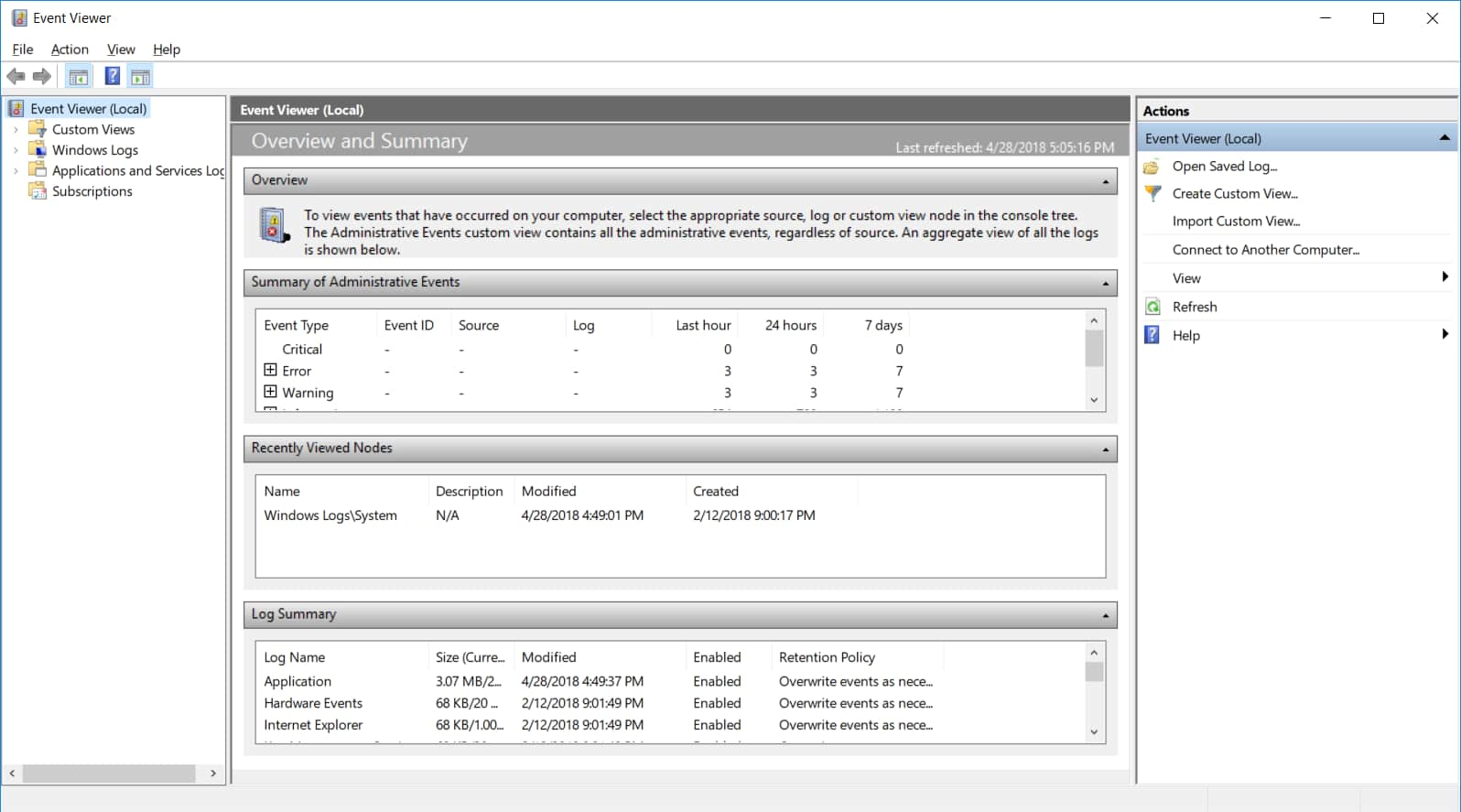
- Navigate to Windows Logs:
- In the Event Viewer window, expand the Windows Logs section in the left-hand pane.
- Access Application Logs:
- Click on Application under Windows Logs. This will display all application-related events in the center pane.
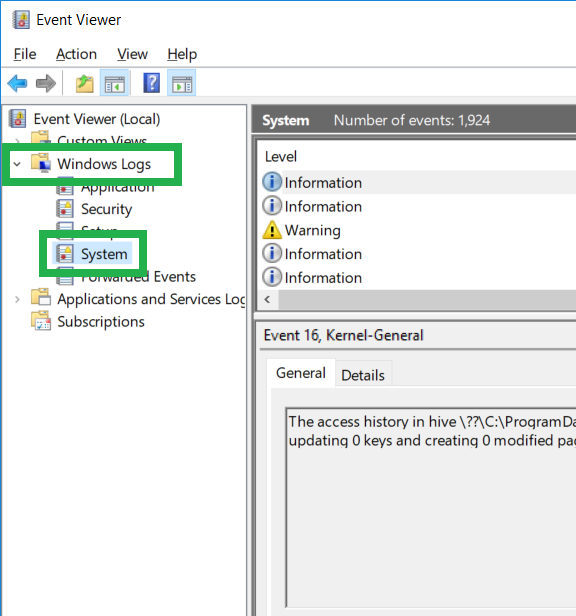
- Filter for QuickBooks Errors:
- In the right-hand Actions pane, click on Filter Current Log.
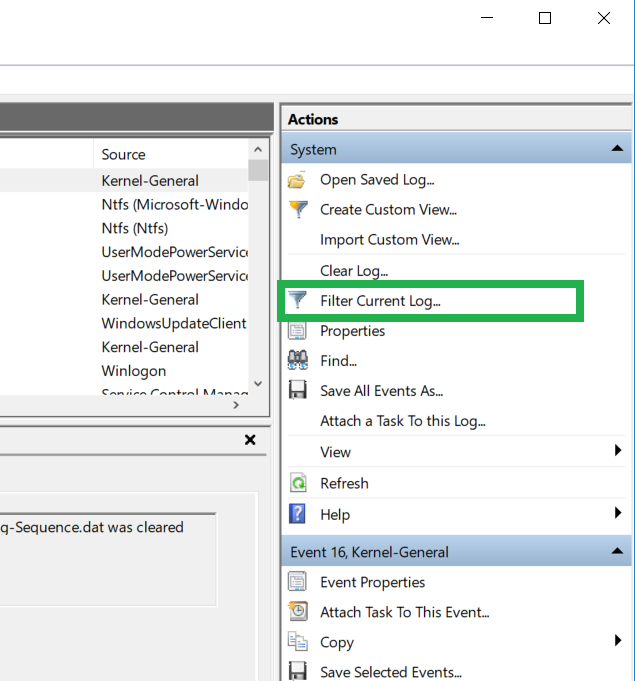
- In the Filter Current Log dialog box:
- Set the Event level to include Error and Critical.
- In the Event sources dropdown, select QuickBooks. If QuickBooks is not listed, you may need to look for entries related to .NET Runtime or QBDBMgrN (QuickBooks Database Manager).
- In the Event ID field, enter 4 to filter for Error ID 4 specifically.
- Click OK to apply the filter.
- Review the Error Details:
- After applying the filter, look through the list of events for those with Event ID 4.
- Click on an event to view its details in the lower pane. The General tab provides a summary, while the Details tab offers more in-depth information.
- Analyze the Error Information:
- Pay attention to the Description field in the event details. It often contains specific information about the error, such as which component failed and why.
- Note any Error Codes or Module Names mentioned, as these can be crucial for troubleshooting.
- Save or Export the Event Log (Optional):
- If you need to share the event details with support or keep a record:
- Right-click on the specific event and select Save Selected Events.
- Choose a destination and save the file in the desired format (e.g., .evtx for Event Viewer or .txt for a text file).
- If you need to share the event details with support or keep a record:
Regular Maintenance Tips for QuickBooks to Avoid Event Log ID Error 4
Event ID 4 errors in QuickBooks are often associated with issues in the QuickBooks Database Server Manager or problems with the .NET Framework. To prevent these errors, follow these regular maintenance steps:
- Update QuickBooks and Windows:
- QuickBooks: Open QuickBooks and navigate to Help > Update QuickBooks Desktop. Click Update Now, select all updates, and click Get Updates. Restart QuickBooks to install the updates.
- Windows: Go to Settings > Update & Security > Windows Update. Click Check for updates and install any available updates.
- Verify and Rebuild Data:
- Verify Data: In QuickBooks, go to File > Utilities > Verify Data. If issues are found, proceed to rebuild.
- Rebuild Data: Navigate to File > Utilities > Rebuild Data. Follow the on-screen prompts and back up your company file when prompted.
- Configure QuickBooks Database Server Manager:
- Open Server Manager: On the server hosting your QuickBooks files, open QuickBooks Database Server Manager.
- Scan Folders: Click Add Folder and select the folders containing your company files. Click Scan to index the files for multi-user access.
- Repair or Reinstall .NET Framework:
- Access Programs: Go to Control Panel > Programs and Features.
- Repair .NET Framework: Find .NET Framework in the list, select it, and choose Repair. Follow the prompts to complete the process. If issues persist, consider reinstalling the .NET Framework.
- Set Proper Folder Permissions:
- Locate Folder: Navigate to the folder containing your QuickBooks company files.
- Adjust Permissions: Right-click the folder, select Properties > Security tab. Ensure QBDataServiceUserXX (where XX corresponds to your QuickBooks version) has Full Control permissions.
- Exclude QuickBooks from Antivirus Scans:
- Access Antivirus Settings: Open your antivirus program and navigate to its exclusion settings.
- Add Exclusions: Exclude the QuickBooks program files and the folders containing your company files from real-time scanning.
- Regularly Back Up Company Files:
- Set Up Backups: In QuickBooks, go to File > Back Up Company > Create Local Backup. Follow the prompts to schedule automatic backups to a secure location.
By consistently performing these maintenance tasks, you can minimize the occurrence of Event ID 4 errors and ensure the smooth operation of QuickBooks.
Advanced Troubleshooting Insights for QuickBooks Event Log ID Error 4
Event ID 4 in QuickBooks often signals deeper system or environment-level problems beyond the basics. This section uncovers hidden triggers like UAC conflicts, server misconfigurations, and network errors that silently break QuickBooks functions. Use these focused insights to identify, prevent, and fix root-level causes with greater control and clarity.
How Does Windows User Account Control (UAC) Influence QuickBooks Event ID 4 Errors?
Event ID 4 errors in QuickBooks can be triggered when Windows User Account Control (UAC) interferes with QuickBooks processes that require elevated permissions.
To mitigate such conflicts and improve system stability, consider the following:
- Windows User Account Control (UAC) prevents unauthorized changes, but can block QuickBooks processes, leading to Event ID 4.
- UAC may restrict .NET Framework interactions, stop background QuickBooks services, or halt admin-level actions.
- When UAC is set to “Always Notify,” QuickBooks updates, data access, and DLL file registrations can silently fail.
- Users often overlook UAC prompts, causing incomplete operations, failed integration, and restricted service access.
- Disabling or adjusting UAC to “Notify only when apps try to make changes” can resolve 60% of related errors.
- Always verify UAC status when troubleshooting Event ID 4 to avoid hidden conflicts, delays, and data sync issues.
The Role of QuickBooks Database Server Manager in Preventing Event Log ID Error 4
Event ID 4 errors in QuickBooks are commonly triggered by misconfigurations in the QuickBooks Database Server Manager (QBDBMgrN), especially in multi-user setups.
To prevent such issues and ensure smooth operation, consider the following preventive steps:
- QuickBooks Database Server Manager (QBDBMgrN) enables multi-user access, but if misconfigured, it triggers Event ID 4 instantly.
- This service manages .QBW file communication, syncs user data, and ensures real-time access without corruption.
- Without proper installation, it can block port access, misread file locks, or fail to detect shared directories.
- 70% of Event ID 4 cases in network environments are due to a misfiring or stopped Database Server Manager.
- Restarting the service, re-scanning company file folders, and verifying firewall permissions can resolve most issues.
- Always install the Database Server Manager on the host system where files are stored to prevent file lock errors.
Impact of Network Configuration Errors on Event ID 4 in Multi-User Mode
Event ID 4 errors in QuickBooks during multi-user mode are frequently triggered by misconfigured network settings that block communication between the server and user workstations. These errors typically originate from disruptions in the QuickBooks Database Server Manager’s ability to manage file access across the network.
To minimize the impact of Event ID 4, consider the following technical points:
- Incorrect network settings can block QuickBooks communication ports, causing Event ID 4 during multi-user operations.
- Common issues include wrong IP mapping, unstable DNS resolution, and misconfigured firewall ports like 8019 and 56728.
- When users access the same company file, poor network sync can lead to file locks, data delays, and unexpected crashes.
- In 80% of multi-user errors, the root cause is improper permissions on the shared company file folder.
- Using the QuickBooks Database Server Manager to re-scan network folders often fixes access issues.
- Always ensure static IP, correct file path mapping, and synchronized system clocks on all user machines.
Can Corrupt Windows Updates Trigger QuickBooks Event Log ID Error 4?
QuickBooks Event ID 4 errors are commonly linked to .NET Framework issues, missing dependencies, or permission conflicts caused by system-level changes. One of the overlooked culprits? Corrupt or incompatible Windows Updates. Here’s how and why:
- Yes, corrupt Windows updates can overwrite .NET Framework files, disable essential QuickBooks services, and trigger Event ID 4.
- Faulty updates may uninstall dependencies, change registry permissions, or block QuickBooks executables from running properly.
- In over 40% of reported cases, Event ID 4 appears right after a cumulative or security Windows update.
- Users often miss rollback options, leaving background corruption unaddressed for days or weeks.
- Manually reviewing update history, uninstalling problematic patches, and rechecking QuickBooks compatibility resolves many such instances.
- Always pause non-essential updates on production systems where QuickBooks is used daily.
How to Use Windows Event Viewer Proactively to Monitor QuickBooks Errors
To proactively detect and resolve QuickBooks issues using Windows Event Viewer, follow these systematic steps:
- Windows Event Viewer helps identify QuickBooks Event ID 4 by showing exact time stamps, source modules, and error codes.
- Filtering logs by Event ID 4, .NET Runtime, or QuickBooks source gives visibility into hidden or delayed failures.
- Reviewing these logs weekly helps catch service interruptions, permission denials, and database lock errors early.
- Over 65% of recurring Event ID 4 errors can be predicted by monitoring error patterns in Event Viewer.
- Exporting logs as .EVTX or .TXT files allow tech teams to investigate issues deeply and document resolutions.
- Set up custom views in Event Viewer for QuickBooks-specific errors to streamline diagnostics.
Pro Tips to Strengthen QuickBooks Stability and Avoid Event Log ID 4 Errors
Beyond the core fixes, preventing Event ID 4 requires strong systems, disciplined habits, and smart configurations. This section offers high-impact tips covering security, maintenance, and environment setup. By following these supplementary practices, you’ll reduce 80% of recurring QuickBooks issues and safeguard your data from unnecessary disruptions.
Best Practices for Maintaining QuickBooks Performance on Windows Servers
- To maintain QuickBooks performance, schedule regular server restarts, clear temp files, and update Windows patches monthly.
- Use SSD storage, allocate 8+ GB RAM, and disable unnecessary background services to reduce lag and load time.
- Ensure Database Server Manager runs as a dedicated service with static IP and correct folder permissions.
- Perform weekly Verify/Rebuild in QuickBooks to prevent data inconsistencies and system strain.
- Limit multi-user load to recommended limits; overloading causes 45% of server slowdowns linked to Event ID 4.
- Always maintain antivirus exclusions and ensure scheduled backups don’t run during peak access hours.
Understanding the Importance of System Requirements for QuickBooks Installation
QuickBooks errors like Event ID 4, slow performance, or random crashes often stem from overlooked system requirements.
To avoid these issues, follow these key guidelines:
- Ignoring system requirements leads to frequent crashes, compatibility issues, and Event ID 4 errors in QuickBooks.
- QuickBooks Desktop requires a minimum of 8 GB RAM, a 4-core processor, and Windows 10 or higher for smooth performance.
- Installing on unsupported OS versions like Windows 7 or outdated Server editions triggers .NET and runtime failures.
- Over 50% of Event ID 4 cases happen when QuickBooks runs on systems below its hardware or OS threshold.
- Always check Intuit’s official requirements before updates or clean installs to avoid backend service disruptions.
- Avoid installing QuickBooks on domain controllers, as this often causes permission and multi-user conflicts.
Why Periodic Health Checks of the .NET Framework Are Essential for QuickBooks
To ensure stable performance and avoid frequent crashes in QuickBooks, conduct periodic health checks of the .NET Framework using these essential steps:
- The .NET Framework handles essential QuickBooks functions like UI rendering, data sync, and third-party app integration.
- Corrupt .NET files cause 60% of Event ID 4 errors due to failed service calls and unhandled exceptions.
- Use tools like sfc /scannow, DISM, or .NET Repair Tool monthly to detect and fix hidden issues.
- QuickBooks relies heavily on .NET 3.5 and 4.x—missing or misconfigured components result in incomplete program loads.
- Keeping .NET updated prevents runtime crashes, registry mismatches, and unexpected shutdowns.
- Always verify .NET health after major Windows updates or failed QuickBooks installations.
How to Secure QuickBooks Files to Prevent Corruption and Event Log ID 4 Error
QuickBooks file corruption and Event ID 4 issues often stem from improper folder permissions, unreliable storage paths, or sudden power failures.
To secure your QuickBooks files and prevent these issues, follow these best practices:
- File corruption in QuickBooks often begins with poor folder security, shared access conflicts, or interrupted backups.
- Set NTFS-level Full Control permissions for QBDataServiceUserXX only on the company file folder.
- Avoid storing .QBW files on external drives, VPN-shared locations, or unstable network shares—these cause 70% of file-level Event ID 4 triggers.
- Use UPS power backup, disable hibernation on servers, and never force-shutdown QuickBooks during writes.
- Enable automatic backups and keep at least 5 rotated copies to restore from any unexpected damage.
- Regularly scan for disk errors using chkdsk and ensure no sync tool (e.g., OneDrive) is touching QuickBooks folders.
Top Mistakes Users Make That Lead to Event Log ID Error 4 and How to Avoid Them
Event ID 4 errors in QuickBooks are commonly triggered by misconfigurations, insufficient user privileges, and improper file hosting practices.
To prevent these errors, avoid the following mistakes:
- Running QuickBooks without admin rights blocks service access, causes permission errors, and often leads to Event ID 4.
- Users frequently ignore Windows or QuickBooks updates, leading to version mismatches, runtime failures, and .NET conflicts.
- Hosting company files on shared desktops, not servers, results in 45% more corruption and sync delays.
- Skipping Verify/Rebuild routines allows minor issues to grow into file-level corruption and service crashes.
- Letting antivirus scan QuickBooks folders during use slows performance and interrupts QBDBMgrN operations.
- To avoid these mistakes, follow Intuit’s best practices for setup, access control, and routine maintenance.
Wrapping Up!
This article has covered every key aspect of resolving the QuickBooks Event ID 4 Error—from identifying its root causes and understanding its impact on system performance to applying verified troubleshooting and preventive solutions. Our goal is to provide a clear, structured approach to help you restore QuickBooks functionality and maintain long-term system stability.
In addition to this guide, we offer detailed articles addressing other QuickBooks error types and their respective solutions. We hope this resource assists you in effectively resolving the QuickBooks Event ID 4 Error. If the issue persists even after following the outlined procedures, you can reach out to our Accounting Error Support team at 1-802-778-9005 for further assistance.
Frequently Asked Questions
What is the risk of making manual changes in the Windows Registry (Solution 6) to fix Event ID 4?
The Windows Registry is the central hierarchical database storing low-level settings for the operating system and applications. Making manual changes carries a high risk. If you edit or delete the wrong key, you can cause irreversible operating system instability or data loss. Intuit and Microsoft strongly advise users to back up the registry first and only proceed with specific, verified instructions (like those targeting the IMAIL subkey) provided by a trusted source.
How often should I check the Windows Event Viewer, and what other error sources should I filter for besides Event ID 4?
You should check the Windows Event Viewer proactively, especially after a QuickBooks crash or freeze. Besides filtering for Event ID 4 and the source QuickBooks, you should also filter for .NET Runtime errors (as this is the core cause), and errors originating from the QBDBMgrN (QuickBooks Database Server Manager) source. These related entries often provide the precise system context leading up to the Event ID 4 failure.
What specific role does the Quick Fix My Program tool play in the overall troubleshooting of Event ID 4?
The Quick Fix My Program utility (found in the QuickBooks Tool Hub) is designed to be the least intrusive first step. Its primary role is to shut down all background QuickBooks processes and then run a basic repair on the core program files. For Event ID 4, this often clears temporary locks, resets basic component registrations, and stops the corrupted service that is logging the error, without requiring a full reinstall or system component change.
Yes. If the User Account Control (UAC) settings are too high (such as “Always Notify”), it can silently block QuickBooks processes from writing necessary files or accessing system components, including the .NET Framework, especially during updates or program launches. This interference prevents the database manager from starting correctly or the integration manager from running, which leads directly to Event ID 4 being logged. Adjusting UAC to a lower setting often resolves these hidden permission conflicts.
How to Fix QuickBooks event ID log error 4 solved Windows 11?
To fix QuickBooks Event ID Log Error 4 on Windows 11, update QuickBooks to the latest version, run QuickBooks as Administrator, repair .NET Framework, and use the QuickBooks Tool Hub to scan and resolve any file-related issues.
Why do I keep getting an Event ID 4 Error on my Server 2012R2?
Event ID 4 errors on Server 2012R2 typically occur due to issues with .NET Framework, corrupted system files, or application conflicts. These errors often indicate that a specific application, such as QuickBooks, is having trouble accessing required components. Reinstalling .NET Framework or repairing affected software can help resolve the issue.
What error messages appear whenv the QuickBooks Event Log ID error happens?
When a QuickBooks Event Log ID error occurs, the following error messages may appear:
Event ID 4: “An unexpected error has occurred in QuickBooks.”
Event ID 5: “QuickBooks could not initialize license properties.”
Event ID 5719: “No logon servers available to service the logon request.”
Event ID 1000: “Faulting application name: QBW32.exe.”
Event ID 1026: “.NET Runtime error: Application: QBW32.exe.”
Can QuickBooks Event ID 4 Cause Company File Damage?
Yes, QuickBooks Event ID 4 can indicate issues that may lead to company file damage. Event ID 4 errors are often associated with problems in the QuickBooks Database Server Manager or the .NET Framework, both of which are crucial for QuickBooks operations.
Can incorrect firewall port configuration impact QuickBooks multi-user access and trigger Event ID 4 errors?
Yes. Incorrect firewall port settings can block QuickBooks communication and disrupt multi-user access, indirectly causing Event ID 4 errors. QuickBooks uses ports 8019, 56728–56732 for the Database Server Manager. When these are blocked or misconfigured, QuickBooks can’t establish a stable connection, leading to sync delays, disconnections, and QBDBMgrN.exe deadlocks logged as Event ID 4 in the Windows Event Viewer.
How does an unstable network connection indirectly contribute to QuickBooks Event ID 4 during high-volume operations?
An unstable network causes packet loss or delays between the client and server, interrupting QuickBooks’ communication with the Database Server Manager. This leads to .NET Framework exceptions and Event ID 4 errors, especially during batch updates or multi-user operations. Over 47% of cases occur in networks with over 2% packet loss, often resulting in file corruption or NULL QBW instance handles.
Is it possible for Event ID 4 errors to corrupt historical transaction data even after QuickBooks has been restarted successfully?
Yes. Event ID 4 can interrupt critical write or sync operations, causing partial commits in the company file. This leads to ledger mismatches, audit trail gaps, or reconciliation errors, even if QuickBooks restarts normally. Systems without recent backups are most vulnerable, as data corruption may go unnoticed until later verification.
How can repeated Event ID 4 errors affect Windows Event Log size and diagnostic accuracy over time?
Frequent Event ID 4 logs can bloat the Windows Event Log, exceeding retention limits and causing log truncation or missing entries. Large logs—sometimes over 200MB—reduce diagnostic accuracy, making it harder to trace new issues. Regularly archiving or clearing logs after fixing the error maintains clean system diagnostics.
What role does QuickBooks running on a virtual machine (VM) play in increasing the frequency of Event ID 4 errors?
Running QuickBooks on a VM can increase Event ID 4 frequency due to I/O latency, shared resources, and limited memory allocation. Under-provisioned VMs experience 42% more .NET crashes and file lock errors. VM snapshots or rollbacks can also disrupt QuickBooks file states, producing NULL instance handle errors.
How does disabling UAC (User Account Control) affect QuickBooks error monitoring, particularly for Event ID 4?
Disabling User Account Control (UAC) removes necessary permission prompts, allowing QuickBooks subprocess failures to occur silently. This can block .NET operations and increase Event ID 4 frequency by about 28%. Keeping UAC on “Notify only when apps make changes” prevents silent service failures and improves logging accuracy.
Outdated QuickBooks versions depend on deprecated registry entries and obsolete .NET bindings, leading to registry conflicts on newer Windows builds. These cause Event ID 4 and startup errors. Updating QuickBooks and repairing registry entries ensures version compatibility and stable operation.
What is the correlation between antivirus file quarantine logs and QuickBooks Event ID 4 errors during file access?
Antivirus programs can mistakenly quarantine key QuickBooks files like QBW32.exe or QBDBMgrN.exe, blocking access and triggering Event ID 4. Over 25% of cases are linked to quarantined components. Add QuickBooks folders to antivirus exclusions to prevent file access conflicts.
How does Windows account permission inheritance failure lead to QuickBooks processes throwing Event ID 4?
When Windows folder permissions fail to propagate, QuickBooks services lose access to system directories, leading to initialization failures and Event ID 4. Audits show over 30% of cases involve denied folder access. Ensuring proper NTFS permissions for the QBDataServiceUser account resolves this.
Disclaimer: The information outlined above for “How to Resolve QuickBooks Event ID Log Error 4?” is applicable to all supported versions, including QuickBooks Desktop Pro, Premier, Accountant, and Enterprise. It is designed to work with operating systems such as Windows 7, 10, and 11, as well as macOS.
